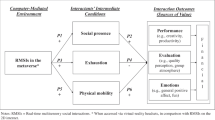Abstract
Tango dancing is not just ethnographically interesting, but might actually provide a way to study interaction as such. An orientation to this improvisational dance as an embodied practice and experience is given. Enactivism is proposed as an adequate framework for further study. It is argued that approaching tango in terms of participatory sense-making, mutual incorporation and consensually coordinated action helps in clarifying its possible contributions to (cultural) psychology. Possible contributions such as facilitating the study of the dynamics of interaction, of intersubjectivity and of culture as joint activity.

Similar content being viewed by others
Notes
For example, an interview with Olga Besio published in the Dutch Tango Magazine ’La Cadena’ in June 2011. http://enflor.nl/besio/.
References
Baerveldt, C., & Verheggen, T. (2012). Enactivism. In J. Valsiner (Ed.), The Oxford Handbook of Culture and Psychology (pp. 165–190). Oxford: Oxford University Press.
Chryssides, I., Dashtipour, P., Keshet, S., Righi, C., Sammut, G., & Sartawi, M. (2009). Commentary: We don’t Share! The Social Representation Approach, Enactivism and the Fundamental Incompatibilities Between the two. Culture and Psychology, 15, 83–95.
De Jaegher, H., & Di Paolo, E. (2007). Participatory Sense-Making. An inactive Approach to Social Cognition. Phenomenology and the Cognitive Sciences, 6, 485–507. doi:10.1007/s11097-007-9076-9.
Di Paolo, E. A. (2005). Autopoiesis, Adaptivity, Teleology, Agency. Phenomenology and the Cognitive Sciences, 4, 97–125.
Español, S. (2011). El contacto psicológico entre cuerpos sonoros en movimiento. Nota editorial del número monográfico Intersubjetividad y Musicalidad Comunicativa. Psicología del Desarrollo, 2
Fuchs, T., & De Jaegher, H. (2009). Enactive Intersubjectivity: Participatory Sense-Making and Mutual Incorporation. Phenomenology and the Cognitive Sciences, 8, 465–486. doi:10.1007/s11097-009-9136-4.
Grossen, M. (2010). Interaction Analysis and Psychology: A Dialogical Perspective. Integrative Psychological and Behavioral Science, 44, 1–22. doi:10.1007/s12124-009-9108-9.
Kimmel, M. (2012). Intersubjectivity at Close Quarters: How Dancers of Tango Argentino Use Imagery for Interaction and Improvisation. Journal of Cognitive Semiotics, 4(1), 76–124.
Luckmann, T. (2008). On Social Interaction and the Communicative Construction of Personal Identity, Knowledge and Reality. Organization Studies, 29(2), 277–290.
Malloch, S., & Trevarthen, C. (Eds.). (2009). Communicative Musicality. Exploring the Basis of Human Companionship. Oxford: Oxford University Press.
Marechal, L. (1970). Megafón o la Guerra. Buenos Aires: Editorial Planeta y Perfil Libros.
McGann, M., & De Jaegher, H. (2009). Self–Other Contingencies: Enacting Social Perception. Phenomenology and the Cognitive Sciences, 8, 417–437. doi:10.1007/s11097-009-9141-7.
McGann, M., De Jaegher, H., & Di Paolo, E. (2013). Enaction and Psychology. Review of General Psychology, 17(2), 203–209. doi:10.1037/a0032935.
Olsewski, B. (2008). El Cuerpo del Baile: The Kinetic and Social Fundaments of Tango. Body and Society, 14(2), 63–81.
Rosa, A. (2007). Acts of Psyche: Actuation as Synthesis of Semiosis and Action. In J. Valsiner & A. Rosa (Eds.), The Cambridge Handbook of Sociocultural Psychology (pp. 205–237). Cambridge: Cambridge University Press.
Tateo, L. (2014). The Dialogical. Dance: Self, Identity Construction, Positioning and Embodiment in Tango Dancers. Integrative Psychological and Behavioral Science. doi:10.1007/s12124-014-9258-2.
Thompson, E. (2007). Mind in life: Biology, phenomenology, and the sciences of mind. Harvard University Press
Varela, F. J. (1997). Patterns of Life: Intertwining Identity and Cognition. Brain and Cognition, 34, 72–87.
Varela, F. J., Thompson, E., & Rosch, E. (1991). The Embodied Mind: Cognitive Science and Human Experience. Cambridge: MIT Press.
Verheggen, T., & Baerveldt, C. (2007). We don’t Share! The Social Representation Approach, Enactivism and the Fundamental Incompatibilities Between the two. Culture and Psychology, 13, 5–27.
Verheggen, T., & Baerveldt, C. (2012). Mixed up Perspectives: Reply to Chryssides et al. And Daanen and Their Critique of Enactive Cultural Psychology. Culture and Psychology, 18, 272–284.
Acknowledgments
This paper would not have been possible without the inspiring conversations with and kind help of Ezequiel Di Paolo at the University of Basque Country.
Funding
The author receives a scholarship from CONICET (Consejo Nacional de Investigaciones Científicas y Técnicas) Argentina.
Author information
Authors and Affiliations
Corresponding author
Rights and permissions
About this article
Cite this article
van Alphen, F. Tango and Enactivism: First Steps in Exploring the Dynamics and Experience of Interaction. Integr. psych. behav. 48, 322–331 (2014). https://doi.org/10.1007/s12124-014-9267-1
Published:
Issue Date:
DOI: https://doi.org/10.1007/s12124-014-9267-1




